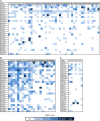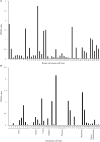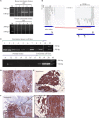Olfactory Receptors as Biomarkers in Human Breast Carcinoma Tissues
- PMID: 29497600
- PMCID: PMC5818398
- DOI: 10.3389/fonc.2018.00033
Olfactory Receptors as Biomarkers in Human Breast Carcinoma Tissues
Abstract
Olfactory receptors (ORs) are known to be expressed in a variety of human tissues and act on different physiological processes, such as cell migration, proliferation, or secretion and have been found to function as biomarkers for carcinoma tissues of prostate, lung, and small intestine. In this study, we analyzed the OR expression profiles of several different carcinoma tissues, with a focus on breast cancer. The expression of OR2B6 was detectable in breast carcinoma tissues; here, transcripts of OR2B6 were detected in 73% of all breast carcinoma cell lines and in over 80% of all of the breast carcinoma tissues analyzed. Interestingly, there was no expression of OR2B6 observed in healthy tissues. Immunohistochemical staining of OR2B6 in breast carcinoma tissues revealed a distinct staining pattern of carcinoma cells. Furthermore, we detected a fusion transcript containing part of the coding exon of OR2B6 as a part of a splice variant of the histone HIST1H2BO transcript. In addition, in cancer tissues and cell lines derived from lung, pancreas, and brain, OR expression patterns were compared to that of corresponding healthy tissues. The number of ORs detected in lung carcinoma tissues was significantly reduced in comparison to the surrounding healthy tissues. In pancreatic carcinoma tissues, OR4C6 was considerably more highly expressed in comparison to the respective healthy tissues. We detected OR2B6 as a potential biomarker for breast carcinoma tissues.
Keywords: OR2B6; RNA-Seq; biomarker; breast carcinoma; next-generation sequencing; olfactory receptors; pancreatic carcinoma.
Figures





Comment in
-
Duftrezeptor als Angriffsziel für Blasenkrebs-Therapie.Aktuelle Urol. 2018 Sep;49(5):390-391. doi: 10.1055/a-0686-3606. Epub 2018 Sep 5. Aktuelle Urol. 2018. PMID: 30184594 Review. German. No abstract available.
References
-
- Veitinger S, Hatt H. Ectopic Expression of Mammalian Olfactory Receptors. In: Buettner, Andrea editors. Springer Handbook of Odor, Springer Handbooks. Cham: Springer; (2017), p. 83–84.
LinkOut - more resources
Full Text Sources
Other Literature Sources

